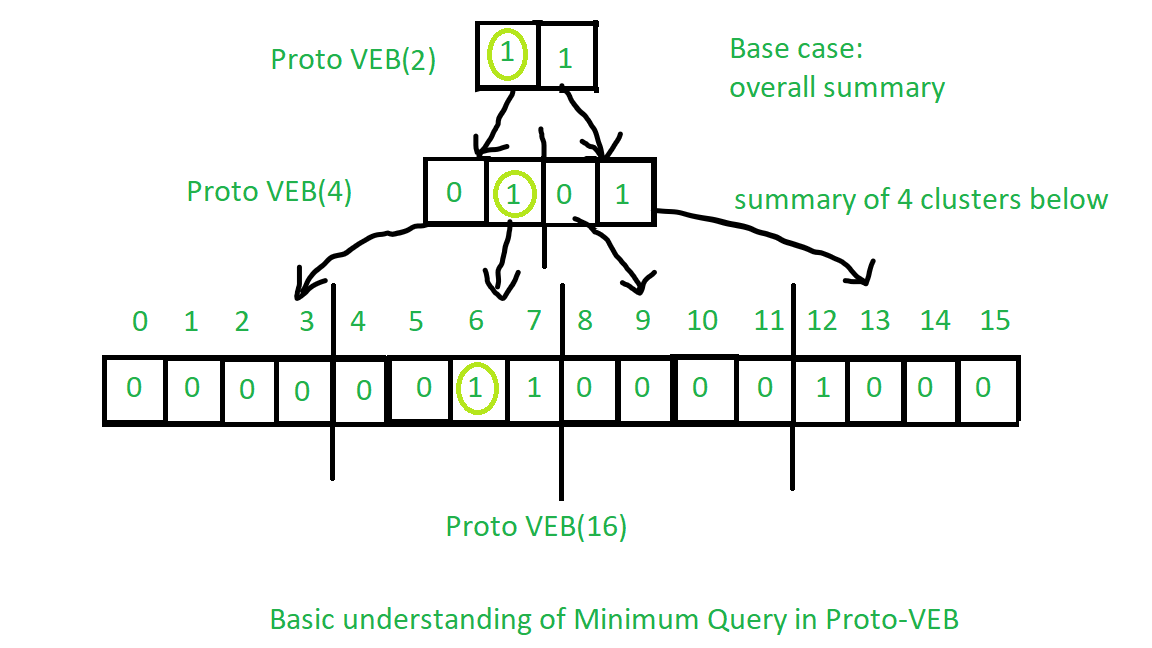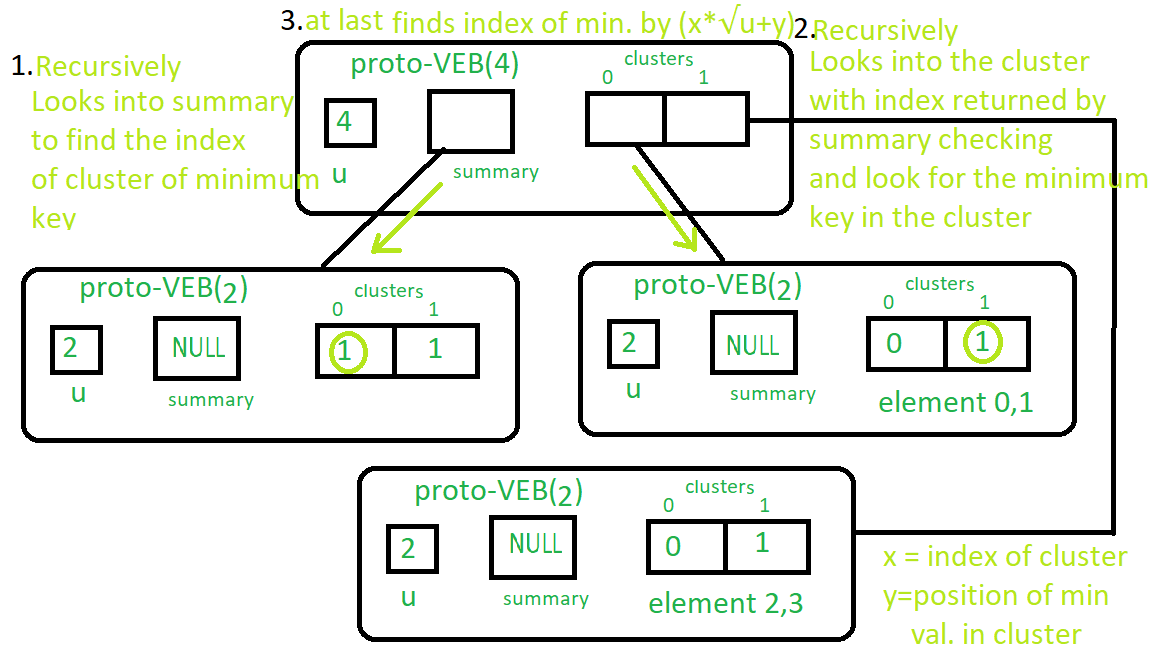请首先查看Proto Van Emde Boas树的先前文章。强烈建议。
查找最低限度的程序:
- 基本情况:如果Proto-VEB的大小为2,则如果不存在密钥,我们将返回群集中存在的最小密钥,然后我们将返回-1作为不存在密钥的符号。
- 递归:
- 我们将对摘要进行递归,直到达到第一个真值(在代码中,摘要集群中的第一个不是nullptr),这表明该集群中存在键。
- 现在,我们将通过再次递归调用集群来查找集群中键的位置,以如上所述找到集群中的第一个真值(在代码中,集群中的第一个不是nullptr)。
- 最后,我们将根据在最后一步中从过程获得的簇号和总结以及从过程中获得的簇的位置,返回该键的索引。
有关操作的基本理解,请参见下图:
从上到下观察浅绿色的圆圈:

有关真正的Proto – VEB最低操作,请参见下图:
请按照说明进行编号。 
您可以轻松地从最小过程中获得最大的想法。见下图:
从上到下观察浅绿色的圆圈:

以上算法的实现:
// C++ implementation of the approach
#include
using namespace std;
class Proto_Van_Emde_Boas {
public:
// Total number of keys
int universe_size;
// Summary
Proto_Van_Emde_Boas* summary;
// Clusters array of Proto-VEB pointers
vector clusters;
int root(int u)
{
return int(sqrt(u));
}
// Function to return cluster numbers
// in which key is present
int high(int x)
{
return x / root(universe_size);
}
// Function to return position of x in cluster
int low(int x)
{
return x % root(universe_size);
}
// Function to return the index from
// cluster number and position
int generate_index(int cluster, int position)
{
return cluster * root(universe_size) + position;
}
// Constructor
Proto_Van_Emde_Boas(int size)
{
universe_size = size;
// Base case
if (size <= 2) {
// Set summary to nullptr as there is no
// more summary for size 2
summary = nullptr;
// Vector of two pointers
// nullptr in starting
clusters = vector(size, nullptr);
}
else {
// Assiging Proto-VEB(sqrt(u)) to summary
summary = new Proto_Van_Emde_Boas(root(size));
// Creating array of Proto-VEB Tree pointers of size sqrt(u)
// first all nullptrs are going to assign
clusters = vector(root(size), nullptr);
// Assigning Proto-VEB(sqrt(u)) to all its clusters
for (int i = 0; i < root(size); i++) {
clusters[i] = new Proto_Van_Emde_Boas(root(size));
}
}
}
};
// Function that returns true if the
// key is present in the tree
bool isMember(Proto_Van_Emde_Boas* helper, int key)
{
// If key is greater then universe_size then
// returns false
if (key >= helper->universe_size)
return false;
// If we reach at base case
// the just return whether
// pointer is nullptr then false
// else return true
if (helper->universe_size == 2) {
return helper->clusters[key];
}
else {
// Recursively go deep into the
// level of Proto-VEB tree using its
// cluster index and its position
return isMember(helper->clusters[helper->high(key)],
helper->low(key));
}
}
// Function to insert a key in the tree
void insert(Proto_Van_Emde_Boas*& helper, int key)
{
// If we reach at base case
// then assign Proto-VEB(1) in place
// of nullptr
if (helper->universe_size == 2) {
helper->clusters[key] = new Proto_Van_Emde_Boas(1);
}
else {
// Recursively using index of cluster and its
// position in cluster
insert(helper->clusters[helper->high(key)],
helper->low(key));
// Also do the same recusion in summary VEB
insert(helper->summary, helper->high(key));
}
}
// Function to return the minimum key from the tree
int minimum(Proto_Van_Emde_Boas* helper)
{
// Base case choses the least key
// present in the cluster
if (helper->universe_size == 2) {
if (helper->clusters[0]) {
return 0;
}
else if (helper->clusters[1]) {
return 1;
}
// No keys present then return -1
return -1;
}
else {
// Recursively find in summary for
// first 1 present in Proto-VEB
int minimum_cluster = minimum(helper->summary);
int offset;
// If no key is present in
// the cluster then return -1
if (minimum_cluster == -1) {
return -1;
}
else {
// Recursively find the position of the key
// in the minimum_cluster
offset = minimum(helper->clusters[minimum_cluster]);
// Returns overall index of minimum key
return helper->generate_index(minimum_cluster, offset);
}
}
}
// Function to return the maximum key from the tree
int maximum(Proto_Van_Emde_Boas* helper)
{
// Return the maximum key present in
// the cluster
if (helper->universe_size == 2) {
if (helper->clusters[1]) {
return 1;
}
else if (helper->clusters[0]) {
return 0;
}
// Return -1 if no keys present in the
// cluster
return -1;
}
else {
// Recursively find the last 1 present
// in the summary
int maximum_cluster = maximum(helper->summary);
int offset;
// If no key is present in
// the cluster then return -1
if (maximum_cluster == -1) {
return -1;
}
else {
// Recursively find the position of the key
// in the maximum_cluster
offset = maximum(helper->clusters[maximum_cluster]);
return helper->generate_index(maximum_cluster, offset);
}
}
}
// Function to delete a key from the tree
void pveb_delete(Proto_Van_Emde_Boas*& helper, int key)
{
// Base case: If the key is present
// then make it nullptr
if (helper->universe_size == 2) {
if (helper->clusters[key]) {
delete helper->clusters[key];
helper->clusters[key] = nullptr;
}
}
else {
// Recursive delete to reach at the base case
pveb_delete(helper->clusters[helper->high(key)], helper->low(key));
bool isanyinCluster = false;
// Iterate over the cluster of keys to check whether
// any other key is present within that cluster
// If yes then we should not update summary to 0
// else update summary to 0
for (int i = helper->high(key) * helper->root(helper->universe_size);
i < (helper->high(key) + 1) * helper->root(helper->universe_size);
i++) {
// If member is present then break the loop
if (isMember(helper->clusters[helper->high(key)], i)) {
isanyinCluster = true;
break;
}
}
// If no member is present then
// update summary to zero
if (isanyinCluster == false) {
pveb_delete(helper->summary, helper->high(key));
}
}
}
// Driver code
int main()
{
Proto_Van_Emde_Boas* hello = new Proto_Van_Emde_Boas(4);
cout << boolalpha;
insert(hello, 2);
insert(hello, 3);
cout << minimum(hello) << endl;
cout << maximum(hello) << endl;
}
最小和最大查询都以O(log2(u))时间复杂度运行。
递归关系:
T(u)= 2T( ![]() )+ O(1)
)+ O(1)